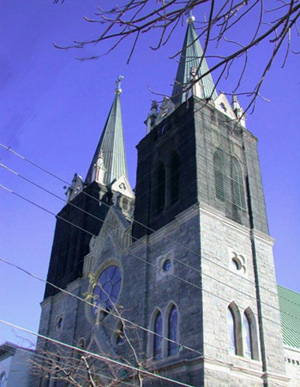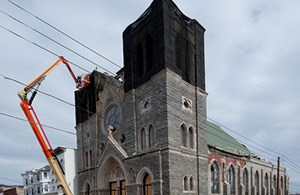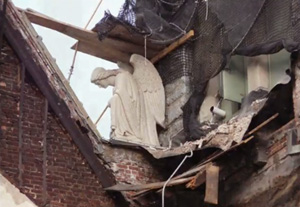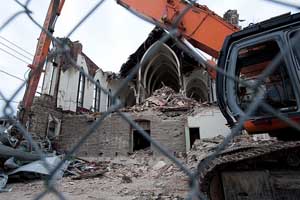 |
Consequences of Vatican II
St. George Church Betrayed for Dollars
The parishioners of St. George Church made a valiant effort to save their historic Church. In September 2009 they filled a civil suit that challenged the Diocesan claim that the Church could not be repaired because of exorbitant costs. The Diocese had refused to consider the parishioners’ arguments that this was not the case. On December 1, 2009, the court ruled that the plaintiffs did not have a property interest in the Church and, therefore, lacked the rights to interfere with the Diocese of Allentown's plan to demolish.
The demolition started in December 2009, and today nothing stands of the beautiful two-towered Church and Lithuanian landmark in America. This letter was sent to us by one of our Readers.

The two towers of historic St. George Church boldly stand before the demolition

The demolition begins

The angels weep

Over a century of tradition razed in a few months
See the moving video
|
As I write this letter with sadness in my heart, I can only think of our parents, grandparents, great-grandparents, and all the first and second generation Lithuanian immigrants who struggled to build the beautiful St. George Church in Shenandoah.
Because of problems and misunderstandings in 1877, the first Church built by the Lithuanian immigrants was taken away from these humble, hardworking people and given to a Polish congregation. The pastor, Rev. Andrew Strupinskas (1872-1877) – the first Lithuanian priest who set foot on American soil – was transferred, and the new priest was assigned who was unable to communicate with the Lithuanian community.
These immigrants pressed on, however, and after several years of worshiping in halls, homes, etc., they managed to raise enough money in 1891 to buy the land and lay the cornerstone at the site of the present St. George Church in downtown Shenadoah. Within a short time, Masses were being held in the basement as the construction continued to rise to become the Cathedral-like Church, which became known as the "Home of the First Lithuanian Parish" in the United States.
Those of us who live in Shenandoah today and throughout the U.S. are well aware of the sacrifices our ancestors made as they built the brick structure and, finally in 1915, added the beautiful Belgian granite block cladding that graced the building until recently.
Despite problems throughout the years, this historical masterpiece stood – the only Church in Shenandoah on solid ground according to the Bureau of Mines. It was well-taken care of and has served the Lithuanian community since 1891.
In the late 1980's, major renovations were begun. Under specialized structural engineers, the Church was transformed into a Beacon of Light – with its majestic white and gold walls, a multitude of original paintings, hand-carved Stations of the Cross, many beautiful statues, and the huge Cross over the main altar, as well as the exceptional Rose Window that glistened above the gilded pipe organ pipes and our 1907 organ in the balcony. A new steel roof expected to last 50 years, and our two copper Steeples for 100 years, were completed in 1992. On December 22, 1992, our hearts swelled with pride, as the two huge steel Crosses were elevated to their positions at the top of the copper Steeples. (Exactly 17 years later on Dec. 22, 2009, the copper steeples were removed as demolition began on the great Church).
During the following 12 years, our charitable parishioners and generous donors helped to finish other work that needed to be done. In early 2004, our pastor, Fr. Potts, told us that on the recommendation of our structural engineers, WJP of Pottsville (designated as the county structural engineers) and our contractors, Houck Specialty Contractors who had won awards for our Towers and Steeples in 1992, it was now time for the granite on the Towers and the facade of the Church to be reset, and the job would cost approximately $360,000. There was no safety issue in 2004.
Instead of the work going forward, the Pastor was transferred and the job was cancelled by the new pastor and the Diocese of Allentown. The cost escalated to $2,000,000 in May 2006 and then $9,000,000 in Janurary 2007 according to the estimates of the Diocese of Allentown - which could not be reviewed and questioned by our structural engineers. This made it clear to the parishioners and other interested parties that the Diocese did not want to save the Church. Over $500,000 in ‘studies’ on the extent of the Church damage was spent that could have been used for renovations.
It was extremely difficult for the parishioners to imagine their Church in this situation. It had always operated in the black and never had to borrow any monies to complete their projects. It paid all the Diocesan assessments and school subsidies and was financially sound.
The Church was intentionally neglected since 2004 by three pastors with the blessing of the Diocese to expedite the plan to take St George apart. The Parishioners were locked out of the Church on May 14, 2006 (Mother's Day). Parishioners were also locked out of the Church Hall where the Fundraising took place.
As of December 22, 2009, 17 years from December 22, 1992 when the two large stainless steel Crosses were raised to the top of the towers, both Crosses are now gone, as are the two main steeples, and 10 bells weighing 12,000 lbs. with the names of the generous donors engraved. If anyone has walked by the area of the demolition, it is obvious to see how difficult it is to take this church apart. The main steeples were constructed of heavy mine timbers, and covered with roofing and copper (expected to last 100 years).
We are told by the Bishop and other clergy that St. George was only a Building. But, to the dedicated people and hard-working miners who carried the sturdy mine timbers and brick in the 1890's and those who carried the expensive Belgian granite which was used for the elegant facade in 1915, this was a consecrated Church, dedicated to God and built for His greater glory.
This Church was the Mother Church for many Lithuanian communities in the United States. Many people of all backgrounds, both Catholic and non-Catholic, came to St. George Church for many events. If the Diocese of Allentown no longer wanted St. George Church, then why didn't the Hierarchy discuss plans with those who wanted to save the Church as a Shrine, or as a Landmark Museum? The Historical Marker that was to be placed in front of the Church was turned away by the current Pastor and by the Diocese of Allentown. According to the PHMC, St. George had a statewide and national historical Significance:
St. George Church is the home of the first Lithuanian parish in the USA that was built by Lithuanian immigrants in 1891. The congregation was formed in 1872, and was led by the nation's First Lithuanian Catholic priest, Rev. Andrew Strupinskas. It served as a center of Lithuanian consecration, culture and heritage.
Many of the surrounding towns and cities have ordinances to protect their historic buildings. Any changes to the historic buildings would have to go through an extensive review process. The State-Historic Commission, the county structural engineers and groups wanting to protect historic buildings would have been involved in the process.
But most of all, I personally am disappointed in the attitude of the Diocese of Allentown, which differs tremendously from what I was taught in the Catholic School System from Kindergarten through college and beyond. I will always believe in God as I was taught. However, I cannot support the Diocese of Allentown, PA, and the actions of the Hierarchy who chose not to involve our structural engineers and the parishioners, relatives and friends of those who built and maintained St George Church. It could have been a win-win situation for everyone.
Dorothy Setcavage, Parishioner of St. George

Posted March 19, 2009

Related Topics of Interest
 Liberalism, Modernism & Progressivism Liberalism, Modernism & Progressivism
 Living on the Edge of the Abyss Living on the Edge of the Abyss
 Vatican II, A Disappearing Mirage Vatican II, A Disappearing Mirage
 Vatican II Revisited Vatican II Revisited
 Gaudium et Spes Was Inspired by Teilhard de Chardin Gaudium et Spes Was Inspired by Teilhard de Chardin
 The State of Mind that Generated the Revolution The State of Mind that Generated the Revolution

Related Works of Interest
|
|
Vatican II | Hot Topics | Home | Books | CDs | Search | Contact Us | Donate

© 2002-
Tradition in Action, Inc. All Rights Reserved
|
 |
|